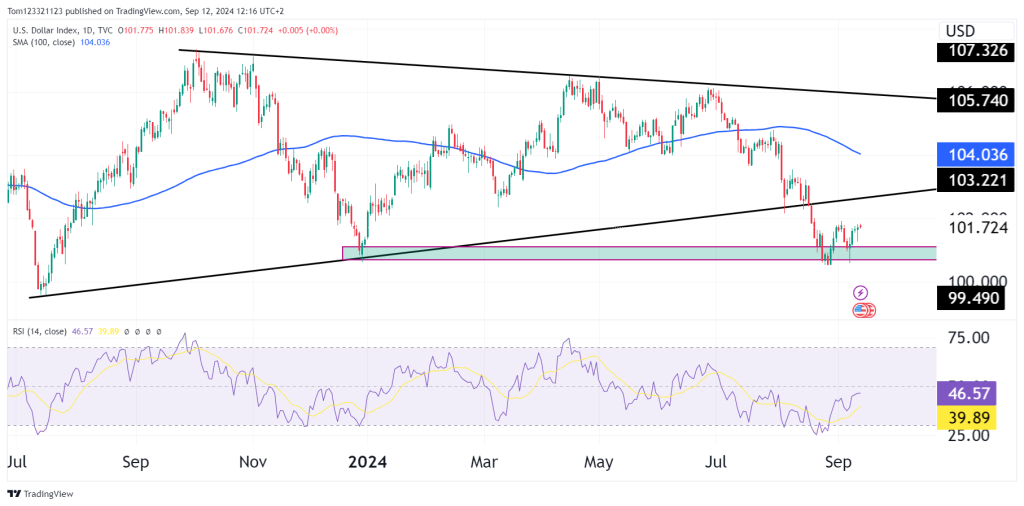Overview of the U.S. Dollar Index (DXY):
The U.S. Dollar Index (DXY) is currently trading around 101.724, showing a recent bounce from a key support level. The DXY has been in a broad descending wedge pattern, which is generally considered a bullish continuation pattern. The bounce from 100.8 to 101.724 is significant, as it coincides with the bottom boundary of this wedge and the area just below the 100-day Simple Moving Average (SMA), a level that has acted as a resistance and support zone.

Key Technical Levels and Patterns:
- Support at 100.8 –101.700: The DXY found support in this zone, which also acted as a major level in the past.
- Descending Wedge Pattern: The price broke below the wedge but bears have been unable to maintain the bearish momentum. At the moment, its difficult to see which direction DXY will turn as it mainly hinges on economic and fundamental factors. However, if we see it rise to test the low side of the wedge at 102.5 it will be pivotal for the price action from there whether that acts as resistance or price pushes through back into the pattern.
Implications for U.S. Equities:
- Equity Market Pressure:
- Rising DXY = Downward Pressure on U.S. Equities: Historically, a stronger dollar tends to act as a headwind for U.S. equity markets, particularly for multinational companies with significant revenue exposure outside of the U.S. When the dollar strengthens, it makes U.S. exports more expensive and can negatively impact earnings growth. The bounce from the 100.8 level in the DXY signals that if the dollar continues to rally, we may see pressure on major U.S. indices like the S&P 500, Nasdaq, and Dow Jones.
- Sector-Specific Impact:
- Technology and Consumer Discretionary: These sectors are particularly sensitive to a stronger dollar, as many of these companies generate a large portion of their revenue abroad. A stronger dollar would lead to foreign revenues translating into fewer U.S. dollars, potentially negatively impacting earnings.
- Financials and Industrials: If the DXY breaks higher, it may provide some support to sectors like financials, as a stronger dollar often aligns with higher interest rates, which generally benefit financial institutions. However, a stronger dollar could weigh on industrials with global exposure.
Implications for Commodities:
- Bearish for Commodities:
- Stronger Dollar = Bearish for Commodities: Commodities like oil, gold, and copper are priced in U.S. dollars, meaning that when the dollar rises, these commodities tend to fall in price. The recent bounce from support levels in the DXY could therefore signal short-term weakness in commodities. A breakout above 102.5 in the DXY would likely exacerbate this pressure, causing commodities to correct lower.
- Gold and Precious Metals: The RSI on the DXY is not yet oversold, so a further dollar rally could weigh on gold prices, which typically move inversely to the U.S. dollar. A stronger DXY would likely push gold back down from its recent highs, and silver and other precious metals would follow suit.
- Oil and Energy: Rising DXY could also negatively impact oil prices, as a stronger dollar makes oil more expensive in other currencies. This could dampen demand and lead to a correction in crude oil prices, especially given the importance of the dollar in international oil markets.
- Bullish Scenario for Commodities:
- If the DXY fails to move higher and turns back lower, commodities could find renewed strength. Oil, gold, and other raw materials would likely see bullish momentum if the dollar weakens from current levels.
Broader Implications for the Global Economy:
- Emerging Markets:
- Emerging market equities and debt are particularly sensitive to the U.S. dollar’s movements. A stronger DXY would put pressure on these markets as their debt obligations become more expensive, and it typically leads to capital outflows from these regions.
- Inflation and Interest Rates:
- A stronger dollar could help cool inflationary pressures within the U.S. by reducing the cost of imports, which in turn might give the Federal Reserve some room to pause interest rate hikes. Conversely, a weaker dollar might put renewed pressure on inflation, forcing central banks to keep rates higher for longer.
Conclusion:
In the near term, all eyes should be on the key technical levels: the 102.5 resistance and the 100.8 support. A break in either direction will have significant implications for equities, commodities, and global markets.
No direct trade recommendations for DXY since it’s not a tradable product, but the movements of the dollar index remain essential for broader market analysis and understanding risk-on or risk-off sentiment.



